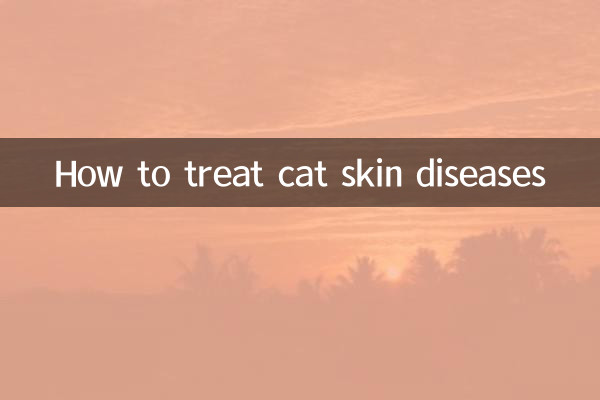How to treat cat skin diseases
Cat skin diseases are one of the common problems faced by pet owners. They not only affect the health of cats, but may also lead to more serious infections. Recently, there has been a lot of discussion on cat skin diseases on the Internet. Especially in the hot and humid environment in summer, the incidence of skin diseases has increased significantly. This article will combine hot topics and hot content in the past 10 days to provide pet owners with detailed treatment plans and prevention suggestions.
1. Common types of cat skin diseases

According to recent search data, the main types of cat skin diseases include fungal infections, bacterial infections, parasitic infections, and allergic dermatitis. The following are several skin diseases that have been highly discussed on the Internet in the past 10 days:
| Skin disease type | Main symptoms | Popular discussion keywords |
|---|---|---|
| Fungal infections (such as cat ringworm) | Circular hair loss, skin redness, swelling, and dandruff | Cat ringworm, fungal medicine, itraconazole |
| bacterial infection | Pustules, skin ulcers, odor | Antibiotics, pyoderma, anti-inflammatories |
| Parasitic infections (such as mites) | Severe itching, skin crusting, and hair loss | Mites, anthelmintics, external anthelmintics |
| allergic dermatitis | Red skin, itching, and frequent scratching | Allergens, anti-allergic drugs, food allergies |
2. Treatment methods for cat skin diseases
Different types of skin diseases have different treatments. The following are the treatment options that have been hotly discussed on the Internet in the past 10 days:
| Skin disease type | Recommended treatments | Things to note |
|---|---|---|
| fungal infection | Topical antifungal creams (such as clotrimazole), oral itraconazole | Avoid contact with other pets and disinfect the environment |
| bacterial infection | Topical antibiotic ointments (such as erythromycin), oral antibiotics | Keep the wound clean and prevent licking |
| parasitic infection | External anthelmintics (such as Big Pet), medicated bath treatment | Regularly deworm and clean the living environment |
| allergic dermatitis | Anti-allergy drugs (such as prednisone), elimination of allergens | Record dietary and environmental changes to identify allergens |
3. Preventive measures for cat skin diseases
The key to preventing cat skin diseases lies in daily care and environmental management. The following are the prevention suggestions that have been hotly discussed across the Internet in the past 10 days:
1.Regular deworming:Use external anthelmintics monthly to prevent fleas, mites and other parasitic infections.
2.Keep it clean:Bathe your cat regularly and use pet-specific shower gel to avoid dry skin.
3.Nutritionally balanced:Provide high-quality cat food, supplement Omega-3 fatty acids, and enhance skin resistance.
4.Environmental disinfection:Clean cat litter, toys and other supplies regularly to reduce the growth of fungi and bacteria.
5.Avoid allergens:Pay attention to changes in your cat's diet and environment to reduce exposure to substances that may trigger allergies.
4. Recent hot topics: Cat skin diseases are more common in summer
In the past 10 days, the amount of discussion on "summer cat skin diseases" has increased significantly across the Internet. High temperature and humid environments can easily lead to the growth of fungi and bacteria. Pet owners need to pay special attention to the following issues:
| Popular questions | solution |
|---|---|
| Cat ringworm reoccurs | Strengthen environmental disinfection, avoid moisture, and use antifungal sprays |
| Cat scratches frequently | Wear an Elizabethan band, use anti-itch medication, and check for parasites |
| Skin sores and infections | Seek medical attention promptly to avoid self-medication that may worsen your condition |
5. Summary
Treatment of feline skin diseases requires targeted measures based on the specific type, but prevention is equally important. Summer is a period of high incidence of skin diseases. Pet owners should strengthen daily care, check the skin condition of cats regularly, and seek medical treatment promptly if any problems are found. Through scientific treatment and prevention, cats’ skin diseases can be effectively reduced, allowing them to live healthy and happy lives.

check the details

check the details